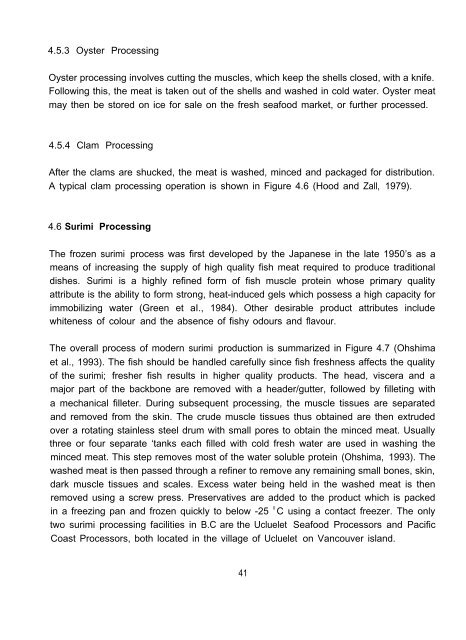9420.pdf
9420.pdf
9420.pdf
Create successful ePaper yourself
Turn your PDF publications into a flip-book with our unique Google optimized e-Paper software.
4.5.3 Oyster Processing<br />
Oyster processing involves cutting the muscles, which keep the shells closed, with a knife.<br />
Following this, the meat is taken out of the shells and washed in cold water. Oyster meat<br />
may then be stored on ice for sale on the fresh seafood market, or further processed.<br />
4.5.4 Clam Processing<br />
After the clams are shucked, the meat is washed, minced and packaged for distribution.<br />
A typical clam processing operation is shown in Figure 4.6 (Hood and Zall, 1979).<br />
4.6 Surimi Processing<br />
The frozen surimi process was first developed by the Japanese in the late 1950’s as a<br />
means of increasing the supply of high quality fish meat required to produce traditional<br />
dishes. Surimi is a highly refined form of fish muscle protein whose primary quality<br />
attribute is the ability to form strong, heat-induced gels which possess a high capacity for<br />
immobilizing water (Green et aI., 1984). Other desirable product attributes include<br />
whiteness of colour and the absence of fishy odours and flavour.<br />
The overall process of modern surimi production is summarized in Figure 4.7 (Ohshima<br />
et al., 1993). The fish should be handled carefully since fish freshness affects the quality<br />
of the surimi; fresher fish results in higher quality products. The head, viscera and a<br />
major part of the backbone are removed with a header/gutter, followed by filleting with<br />
a mechanical filleter. During subsequent processing, the muscle tissues are separated<br />
and removed from the skin. The crude muscle tissues thus obtained are then extruded<br />
over a rotating stainless steel drum with small pores to obtain the minced meat. Usually<br />
three or four separate ‘tanks each filled with cold fresh water are used in washing the<br />
minced meat. This step removes most of the water soluble protein (Ohshima, 1993). The<br />
washed meat is then passed through a refiner to remove any remaining small bones, skin,<br />
dark muscle tissues and scales. Excess water being held in the washed meat is then<br />
removed using a screw press. Preservatives are added to the product which is packed<br />
in a freezing pan and frozen quickly to below -25 0<br />
C using a contact freezer. The only<br />
two surimi processing facilities in B.C are the Ucluelet Seafood Processors and Pacific<br />
Coast Processors, both located in the village of Ucluelet on Vancouver island.<br />
41














